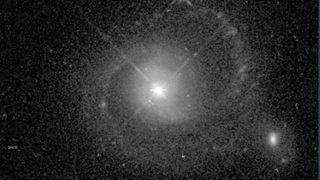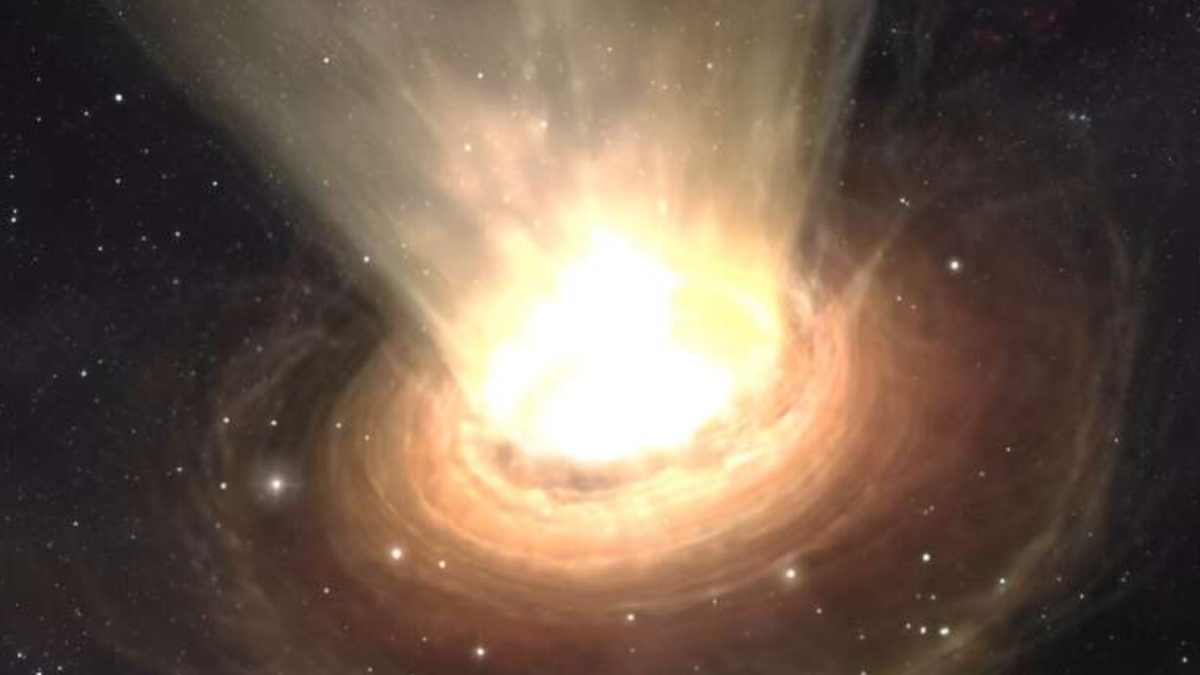Using the Hubble Space Telescope, astronomers have, for the first time ever, mapped the plasma “burps” of a feeding supermassive black hole-powered quasar that dwells relatively close to Earth.
While supermassive black holes with masses millions or billions of times that of the sun are thought to dwell at the heart of all galaxies, not all of these cosmic titans power quasars. Some, like the supermassive black hole at the heart of the Milky Way, called Sagittarius A*, are relatively quiet because they are not greedily feeding on matter around them.
This particular quasar and the ravenous supermassive black hole driving it are located at the active heart of the galaxy Zwicky 1, around 847 million light-years from Earth toward the constellation of Pisces. While this is an incredibly vast distance, the majority of quasars exist in the early universe, meaning they can be billions of light-years away.
Thus, the proximity of this quasar, named “I Zwicky 1,” makes it an excellent lab for studying the extreme conditions around active galactic nuclei (AGN), regions so bright they can outshine the combined light of every star in the galaxies that surround them. That includes the “burps” or outflows of matter from the surroundings of the supermassive black hole.
The supermassive black hole at the heart of Zwicky 1 is estimated to have a mass equivalent to 9.3 million suns. It is thought to consume matter at an incredible rate and produce powerful jets that drive high-speed “burps.” A team of astronomers from the Netherlands Institute for Space Research (SRON) described these outflows for the first time.
“I Zwicky 1 is very special in its properties,” team leader Anna Juráňová said in a statement. “Other quasars have similar outflows, but in this one, everything is just right. Our viewing angle, the width of the lines in the spectrum, and so on. This allows us to dig much deeper into its processes. We have created a global picture of the motions of the ionized gas in a quasar, which is rare.”
How quasars get their outflows
Like all black holes, supermassive black holes are surrounded by an outer boundary called an event horizon. This is the point at which a black hole’s gravitational influence has become so intense that not even light is fast enough to meet its escape velocity.
Because nothing with mass can travel faster than the speed of light, it could lead you to wonder how these outflows escape quasars. The answer is that the material that comprises the outflows never passes the event horizon.
When a supermassive black hole is surrounded by matter, whether gas and dust or the remains of a star that the black hole has shredded with its immense gravity, that matter has angular momentum. That means it can’t fall directly to the black hole and instead forms a spinning flat cloud around the black hole called an “accretion disk.”
Matter in the accretion disk is gradually fed to the central supermassive black hole, but if there is one thing scientists know about black holes, it is that they are messy eaters. Not all the matter in accretion disks is destined to fall into the black hole; some charged particles are channeled to its poles by powerful magnetic fields.
These magnetic fields accelerate the trapped particles to speeds that are a significant fraction of the speed of light, and they are then blasted out as highly collimated jets. These jets and the radiation associated with them push clouds of matter out from around the supermassive black hole, and these are the outflows the team mapped for I Zwicky 1.

Using Hubble, Juráňová and colleagues discovered the properties of four different outflows of plasma from around I Zwicky 1. They found them to be moving at speeds between 134,000 mph (217,000 kph), 200 times the speed of sound, and a staggering 6.5 million mph (10.5 million kph), which is around 8,500 times the speed of sound and around 1% of the speed of light.
The team also discovered that one of the outflows appears to be “caught in the shadow” of another of black hole burp. This happens as radiation from the accretion disk in the form of ultraviolet light is absorbed by elements like nitrogen, oxygen and carbon in clouds of matter in the proximity of the black hole and is pushed away as a result.
Not only is this the first time that astronomers have seen this mechanism at play, but it reveals to the researchers that the immediete surroundings of I Zwicky 1 are more active than the AGN homes of other quasars.
“Our data suggest that far more gas is being lifted and blown out from the disk around the black hole,” Juráňová concluded. “Having this insight brings us closer to unraveling the way these supermassive black holes grow and interact with their surroundings.”
The team’s research was published online Tuesday (June 11) in the journal Astronomy & Astrophysics.




















Discussion about this post